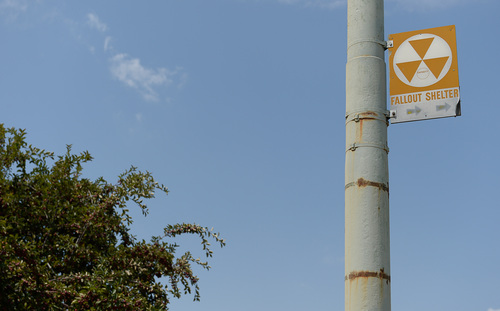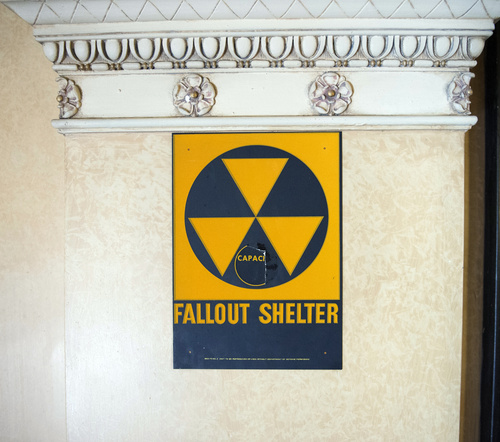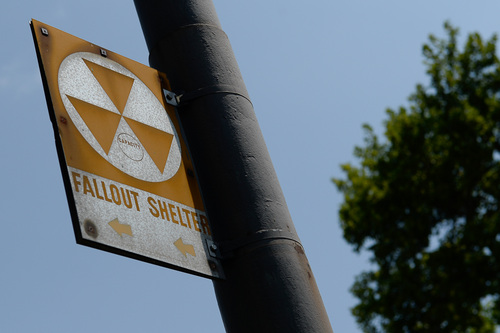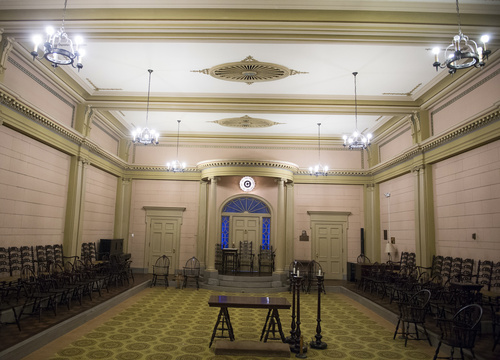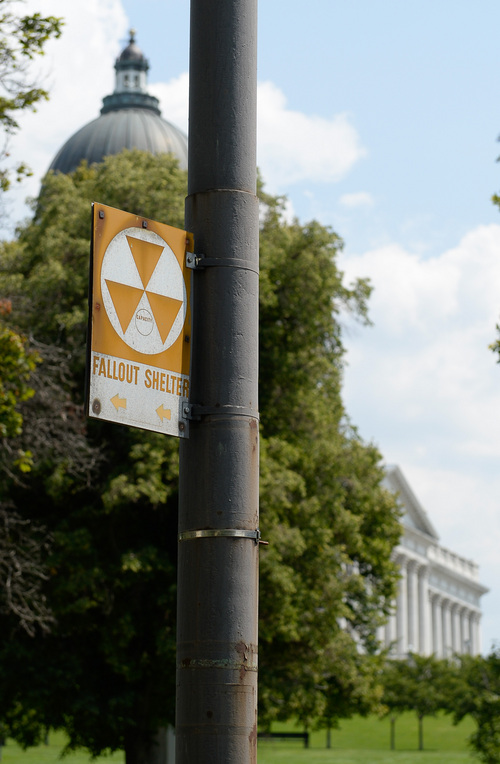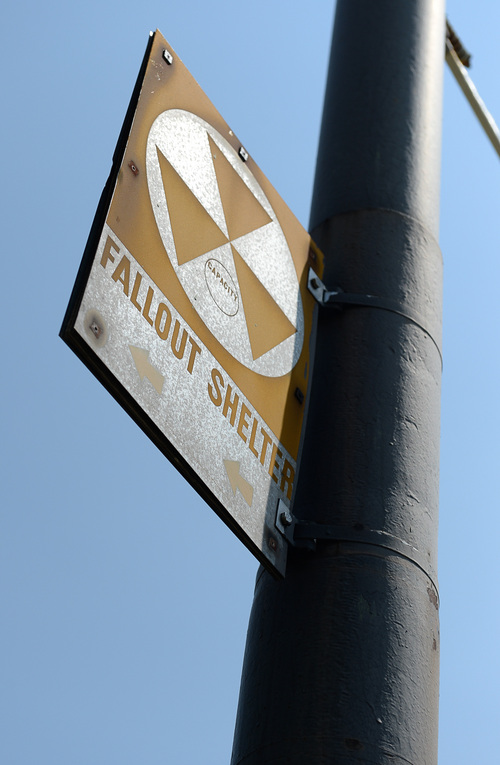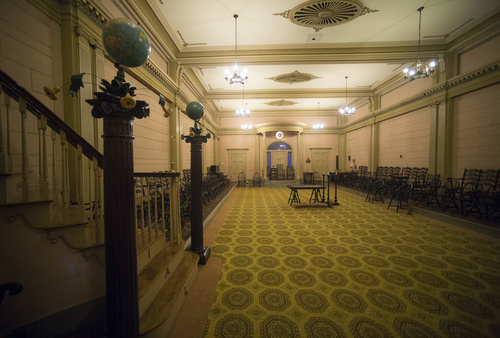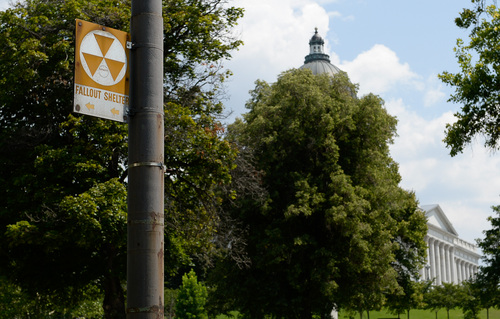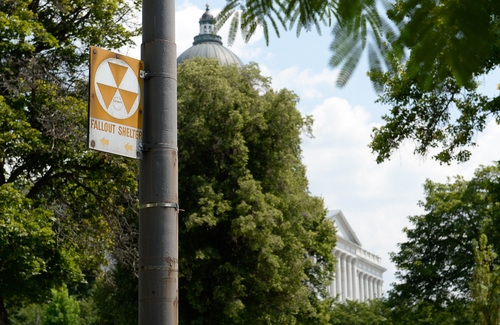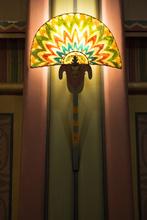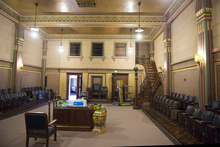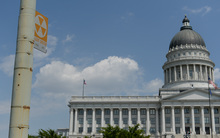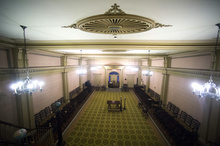This is an archived article that was published on sltrib.com in 2014, and information in the article may be outdated. It is provided only for personal research purposes and may not be reprinted.
Beyond the sphinxes of the Salt Lake Masonic Temple's stone steps — through the giant wooden doors and amid the hushed halls and secretive sanctuaries — is a fallout shelter.
"This building would have come down like a house of cards," said Larry Fairclough, the Masonic society's secretary, walking into a high-ceilinged lounge with tall windows that an atomic blast could have shattered.
Fairclough was unsure what part of the Masonic building would act as a shelter, but he figures it might have been the Colonial Room or Egyptian Room, a pair of romantically decorated sanctuaries for society meetings, which are windowless and built with concrete roofs and floors on a steel frame.
The buildings designated as community fallout shelters during the 1960s were never meant as salvation from the explosion, only sanctuary from the ensuing radiation.
Salt Lake City had at least four — the Masonic temple, the Utah Capitol, the Pioneer Memorial Museum and the YWCA. Now, they're hidden relics.
These paranoia-fueled pledges to survive the apocalypse have quietly faded into the background of everyday life.
Fairclough is old enough to remember the duck-and-cover drills in elementary school. They didn't make him feel safe; quite the opposite.
"They were quite frightening. Girls would cry. By the time I reached fifth grade, I decided that if the bomb ever came," Fairclough said, spreading his arms, "I would just stand up and face it."
Still, the federal government was intent on providing some measure of security.
In 1961, Utah architects and engineers, under the direction of the U.S. Corps of Army Engineers, began surveying buildings and mines that could protect people from nuclear fallout. As part of a nationwide program to survive nuclear holocaust, more than 300 cities and towns in the state requested to be a part of the survey — and, by the 1970s, there were enough public shelters to house Utah's entire population, according to an emergency-services director quoted in a 1977 Salt Lake Tribune article.
It was common for most of the buildings that met the surveyors' criteria to be downtown, said David Monteyne, author of "Fallout Shelter: Designing for Civil Defense in the Cold War." The problem was, downtowns were also often considered primary targets of nuclear attacks.
"If by some miracle you survived the initial explosion," Monteyne said, "then in theory you might shelter for two weeks."
The program slowly fizzled through the 1970s. Some biscuit rations stored in the shelters went rancid. While the federal government never declared an end to the community shelter program, cities began taking down the signs and restoring the shelters to their original purpose.
Now the only evidence of the Masonic temple's designation is a little sign, doom black and radiation yellow, its capacity sticker half gone. It seems fitting that it would hang in a hallway with ancient Egyptian décor; it, like the shelters, fell into antiquity.
Of the signs still left in the city, one hangs from a light pole near 300 N. State St., pointing to the Capitol, and another nearby pointing to the Pioneer Memorial Museum on the opposite side of Main Street.
The Capitol had set aside space for a shelter during the Cold War, but a recent restoration project virtually reconstructed all of the underground areas, so the shelter no longer exists, said Sara Adelman, spokeswoman for the Capitol Preservation Board.
A few blocks southeast from there, near 300 East and 300 South, Anne Burkholder opens a thick door to the YWCA basement. The chief executive officer jokingly tells her assistant at the front desk not to let her get trapped down there. Beyond the door, a twisting flight of stairs descends under the light of a pale fluorescence, a glow that doesn't reach far into the rooms and hallways of the concrete basement below.
"We actually gathered here for the tornado, the one in City Creek," Burkholder said. The rare twister tore through the northern end of downtown in 1999, doing more property damage to the city than a nuke ever did.
She isn't sure exactly when the basement was picked as a shelter, but the building has had several renovations and the dim space is now nothing but storage. Even the designation signs are gone.
The former shelter, though, is actually housed in a storied building that still protects people threatened by violence.
Several decades ago, the YWCA became the first women's domestic violence shelter in the state. While no one is running into its basement to hide from an atom bomb, the building provides sanctuary to those seeking shelter, every day.
Twitter: @mikeypanda —
A former fallout shelter returning to its roots
Anne Burkholder hopes to restore the YWCA to its original design — one conceived by Julia Morgan, the first woman to become a licensed architect in California history. One of Morgan's most prominent claims to fame is the Hearst Castle, the luxurious home of newspaper magnate William Randolph Hearst. Though Morgan designed hundreds of buildings across the country, the YWCA is her only one in Utah, as far as Burkholder knows.
If crews can remodel the building by 2020, she said, that would mark its 100th anniversary since it was built.



